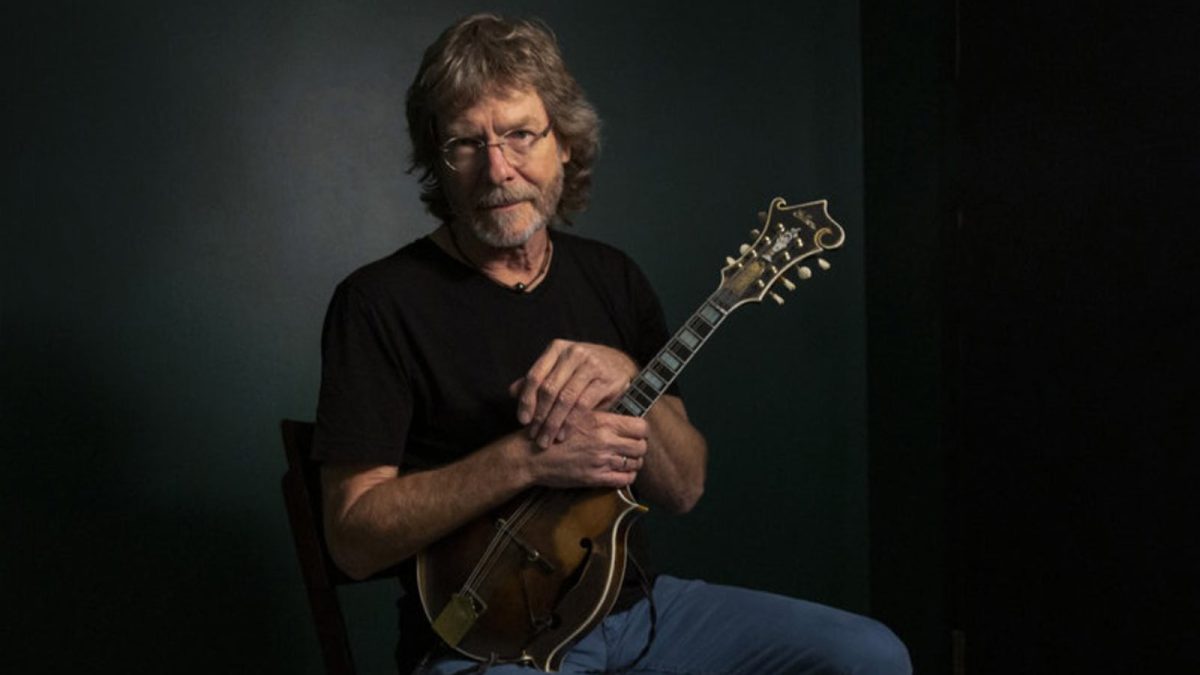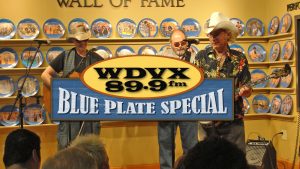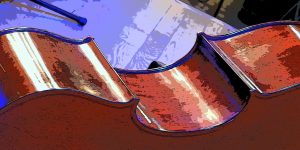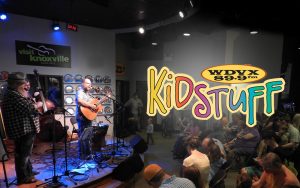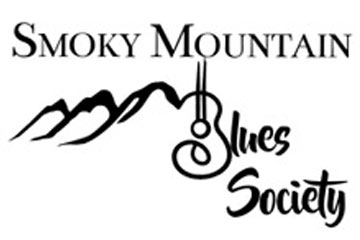
- This event has passed.
ORNL FCU/Summer Sessions – 7/8 – Yarn / Sam Bush
July 8, 2023 @ 6:00 pm
There was only one prize-winning teenager carrying stones big enough to say thanks, but no thanks to Roy Acuff. Only one son of Kentucky finding a light of inspiration from Bill Monroe and his Blue Grass Boys and catching a fire from Bob Marley and The Wailers. Only one progressive hippie allying with like-minded conspirators, rolling out the New Grass revolution, and then leaving the genre’s torch-bearing band behind as it reached its commercial peak.
There is only one consensus pick of peers and predecessors, of the traditionalists, the rebels, and the next gen devotees. Music’s ultimate inside outsider. Or is it outside insider? There is only one Sam Bush.
On a Bowling Green, Kentucky cattle farm in the post-war 1950s, Bush grew up an only son, and with four sisters. His love of music came immediately, encouraged by his parents’ record collection and, particularly, by his father Charlie, a fiddler, who organized local jams. Charlie envisioned his son someday a staff fiddler at the Grand Ole Opry, but a clear day’s signal from Nashville brought to Bush’s television screen a tow-headed boy named Ricky Skaggs playing mandolin with Flatt and Scruggs, and an epiphany for Bush. At 11, he purchased his first mandolin.
As a teen fiddler Bush was a three-time national champion in the junior division of the National Oldtime Fiddler’s Contest. He recorded an instrumental album, Poor Richard’s Almanac as a high school senior and in the spring of 1970 attended the Fiddlers Convention in Union Grove, NC. There he heard the New Deal String Band, taking notice of their rock-inspired brand of progressive bluegrass.
Acuff offered him a spot in his band. Bush politely turned down the country titan. It was not the music he wanted to play. He admired the grace of Flatt & Scruggs, loved Bill Monroe- even saw him perform at the Ryman- but he’d discovered electrified alternatives to tradition in the Osborne Brothers and manifest destiny in The Dillards.
See the photo of a fresh-faced Sam Bush in his shiny blue high school graduation gown, circa 1970. Tufts of blonde hair breaking free of the borders of his squared cap, Bush is smiling, flanked by his proud parents. The next day he was gone, bound for Los Angeles. He got as far as his nerve would take him- Las Vegas- then doubled back to Bowling Green.
“I started working at the Holiday Inn as a busboy,” Bush recalls. “Ebo Walker and Lonnie Peerce came in one night asking if I wanted to come to Louisville and play five nights a week with the Bluegrass Alliance. That was a big, ol’ ‘Hell yes, let’s go.’”
Bush played guitar in the group, then began playing mandolin after recruiting guitarist Tony Rice to the fold. Following a fallout with Peerce in 1971, Bush and his Alliance mates- Walker, Courtney Johnson, and Curtis Burch- formed the New Grass Revival, issuing the band’s debut, New Grass Revival. Walker left soon after, replaced temporarily by Butch Robins, with the quartet solidifying around the arrival of bassist John Cowan.
“There were already people that had deviated from Bill Monroe’s style of bluegrass,” Bush explains. “If anything, we were reviving a newgrass style that had already been started. Our kind of music tended to come from the idea of long jams and rock-&-roll songs.”
Shunned by some traditionalists, New Grass Revival played bluegrass fests slotted in late-night sets for the “long-hairs and hippies.” Quickly becoming a favorite of rock audiences, they garnered the attention of Leon Russell, one of the era’s most popular artists. Russell hired New Grass as his supporting act on a massive tour in 1973 that put the band nightly in front of tens of thousands.
At tour’s end, it was back to headlining six nights a week at an Indiana pizza joint. But, they were resilient, grinding it out on the road. And in 1975 the Revival first played Telluride, Colorado, forming a connection with the region and its fans that has prospered for 45 years.
Bush was the newgrass commando, incorporating a variety of genres into the repertoire. He discovered a sibling similarity with the reggae rhythms of Marley and The Wailers, and, accordingly, developed an ear-turning original style of mandolin playing. The group issued five albums in their first seven years, and in 1979 became Russell’s backing band. By 1981, Johnson and Burch left the group, replaced by banjoist Bela Fleck and guitarist Pat Flynn.
A three-record contract with Capitol Records and a conscious turn to the country market took the Revival to new commercial heights. Bush survived a life-threatening bout with cancer, and returned to the group that’d become more popular than ever. They released chart-climbing singles, made videos, earned Grammy nominations, and, at their zenith, called it quits.
“We were on the verge of getting bigger,” recalls Bush. “Or maybe we’d gone as far as we could. I’d spent 18 years in a four-piece partnership. I needed a break. But, I appreciated the 18 years we had.”
Bush worked the next five years with Emmylou Harris’ Nash Ramblers, then a stint with Lyle Lovett. He took home three-straight IBMA Mandolin Player of the Year awards, 1990-92, (and a fourth in 2007). In 1995 he reunited with Fleck, now a burgeoning superstar, and toured with the Flecktones, reigniting his penchant for improvisation. Then, finally, after a quarter-century of making music with New Grass Revival and collaborating with other bands, Sam Bush went solo.
He’s released seven albums and a live DVD over the past two decades. In 2009, the
Americana Music Association awarded Bush the Lifetime Achievement Award for Instrumentalist. Punch Brothers, Steep Canyon Rangers, and Greensky Bluegrass are just a few present-day bluegrass vanguards among so many musicians he’s influenced. His performances are annual highlights of the festival circuit, with Bush’s joyous perennial appearances at the town’s famed bluegrass fest earning him the title, “King of Telluride.”
“With this band I have now I am free to try anything. Looking back at the last 50 years of playing newgrass, with the elements of jazz improvisation and rock-&-roll, jamming, playing with New Grass Revival, Leon, and Emmylou; it’s a culmination of all of that,” says Bush. “I can unapologetically stand onstage and feel I’m representing those songs well.”
You might expect a band that calls itself Yarn to, naturally, tend to spin a yarn or two. “That’s what we do, we tell stories, live and in the studio, truth and fiction”,singer/songwriter Blake Christiana insists. “We don’t always opt for consistency. There’s a different vibe onstage from what comes through in our recordings. There’s a difference in every show as well, you never know what you’re going to get.”
Yarn’s ability to persevere ought to come as no great surprise, especially for a band that spent two years honing their chops during a Monday night residency at the famed Kenny’s Castaway in New York’s Greenwich Village. In effect, it allowed them to rehearse onstage, mostly in front of audiences that often ranged in size from five to a hundred people on any given night. 10 studio albums followed — Yarn (2007), Empty Pockets (2008), Leftovers Part One (2009), Come On In (2010), Leftovers Part 2 (2011), Almost Home (2012), Shine the Light On (2013), This Is The Year (2016), and Lucky 13 parts 1 & 2 (2019). The band then took to the road, playing upwards of 170 shows a year and sharing stages with such superstars as Dwight Yoakam, Charlie Daniels, Railroad Earth, Marty Stuart, Allison Krauss, Leon Russell, Jim Lauderdale, Leftover Salmon, Amos Lee, The Lumineers and many more. They performed at any number of prestigious venues — Mountain Stage, Daytrotter, the Orange Peel in Asheville, the Fox Theater in Boulder, the 9:30 Club in D.C, South by Southwest, the Strawberry Festival, Rhythm and Roots, Meadowgrass, Floydfest and so much more, eventually surpassing 1,000 shows, half a million miles and performances in nearly every state. They’ve driven nonstop, made countless radio station appearances, driven broken-down RVs and watched as their van caught fire. They’ve paid their dues and then some, looking forward even as they were forced to glance behind.
Indeed, the accolades piled up quickly along the way. They have landed on the Grammy ballot 4 times, garnered nods from the Americana Music Association, placed top five on both Radio and Records and the AMA album charts, garnered airplay on Sirius XM, iTunes, Pandora, CNN, and CMT, been streamed millions of times on Spotify, Apple Music, and Amazon, and also accorded the “Download of the Day” from Rolling Stone. Shine the Light On found shared songwriting credits with John Oates (the Oates of Hall & Oates fame), and when audiences expressed their admiration, it brought the band a populist cult following of diehard devotees, popularly known as “the Yarmy.”
It’s proof positive that the Brooklyn and Raleigh based band have made their mark, and in dealing with their emotions, scars and circumstances, they find themselves in a position to share those experiences with others who have juggled similar sentiments.
As Yarn look forward to their next 2 studio releases in 2023, Blake looks to establish himself more as the songwriter he’s always been, and not the pseudo bluegrass band, bar band or jam band, that Yarn often gets immediately lumped into. Although all those elements of music exist in the Yarn catalogue and their live performances, Blake’s number one priority is and always has been “the song”. These next 2 releases are without a doubt Blake’s most personal, polished, and best of Yarn’s career so far.
The beginning of the journey to these 2 albums began around April of 2022 when Blake booked a solo show at The Down Home in Johnson City, TN (a nod to Townes Van Zandt’s 1986 live show there and ultimate release) with the intention of making a live record. But he wanted it to be songs none of the fans and attendees had ever heard before. The problem was he hadn’t written most of them yet. He was at his crossroads, uninspired, bored, exhausted and fairly insecure about his entire career up to that point. But he got to work, and got more inspired with each new song he wrote. These songs all tell a story individually but they also tell a story as a whole, a songwriter and musician ready to dive deeper into the music and the art for a greater result that he believes most anyone can appreciate, relate to and enjoy.
